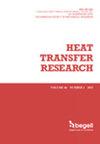COOLING EFFECT OF DIFFERENT TYPES OF MATERIALS IN AN AVIONICS SYSTEM
IF 1.6
4区 工程技术
Q3 THERMODYNAMICS
引用次数: 0
Abstract
Equipment used in the aviation industry heats up over time depending on working conditions. It is possible to preserve the properties of equipment affected by heat by either cooling the system and returning it to initial conditions or by producing the system from materials that are not affected by heat much. One of the areas where nanocomposite materials will be used is avionic systems in the aviation and space industry. These systems are structures in which elements such as sensors, cabling and processors, which form the basis of the electronic structure of flight, are brought together in very small volumes. It is important that the material used in these structures is light and has high strength and has electromagnetic properties selected accordingly. In this study, the thermal analysis of Vapor Grown Carbon Fiber (VGCF) nanocomposite materials produced by adding them to the epoxy matrix in terms of the thermal performance of avionic boxes was carried out by comparing them with the thermal properties of the aluminum material. As a result of the findings obtained from thermal analysis studies carried out in four stages for this purpose; It was observed that by using VGCF composite instead of aluminum material, approximately 23% improvement in temperature output and 17% improvement in thermal load was achieved. Thus, it is anticipated that energy efficiency will be increased with the use of lightweight and high-strength nanocomposite materials, which is considered one of the most important goals of the aviation industry.航空电子系统中不同类型材料的冷却效果
航空工业中使用的设备会随着时间的推移而发热,这取决于工作条件。通过冷却系统并将其恢复到初始状态,或使用不受热量影响的材料生产系统,可以保持受热影响设备的特性。纳米复合材料的应用领域之一是航空和航天工业中的航空电子系统。这些系统是将构成飞行电子结构基础的传感器、电缆和处理器等元件集中在极小体积内的结构。重要的是,这些结构所使用的材料要轻质、高强度,并具有相应的电磁特性。在这项研究中,通过将气相生长碳纤维(VGCF)纳米复合材料添加到环氧树脂基体中,并将其与铝材料的热性能进行比较,从航空箱热性能的角度对其进行了热分析。从为此目的分四个阶段进行的热分析研究中得出的结果显示,使用 VGCF 复合材料替代铝材料后,温度输出提高了约 23%,热负荷提高了 17%。因此,预计随着轻质高强度纳米复合材料的使用,能源效率将得到提高,这被认为是航空业最重要的目标之一。
本文章由计算机程序翻译,如有差异,请以英文原文为准。
求助全文
约1分钟内获得全文
求助全文
来源期刊

Heat Transfer Research
工程技术-热力学
CiteScore
3.10
自引率
23.50%
发文量
102
审稿时长
13.2 months
期刊介绍:
Heat Transfer Research (ISSN1064-2285) presents archived theoretical, applied, and experimental papers selected globally. Selected papers from technical conference proceedings and academic laboratory reports are also published. Papers are selected and reviewed by a group of expert associate editors, guided by a distinguished advisory board, and represent the best of current work in the field. Heat Transfer Research is published under an exclusive license to Begell House, Inc., in full compliance with the International Copyright Convention. Subjects covered in Heat Transfer Research encompass the entire field of heat transfer and relevant areas of fluid dynamics, including conduction, convection and radiation, phase change phenomena including boiling and solidification, heat exchanger design and testing, heat transfer in nuclear reactors, mass transfer, geothermal heat recovery, multi-scale heat transfer, heat and mass transfer in alternative energy systems, and thermophysical properties of materials.
 求助内容:
求助内容: 应助结果提醒方式:
应助结果提醒方式:


